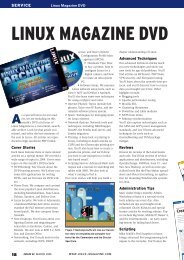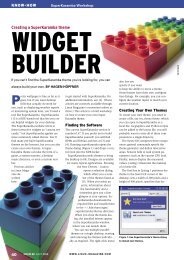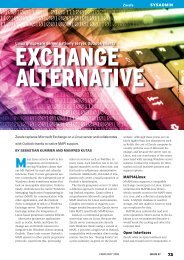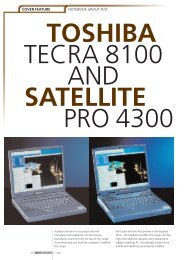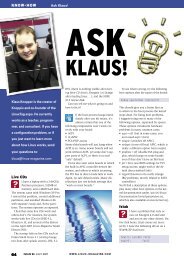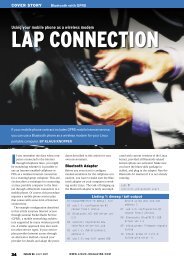VoIP with FreeSWITCH - Linux Magazine
VoIP with FreeSWITCH - Linux Magazine
VoIP with FreeSWITCH - Linux Magazine
You also want an ePaper? Increase the reach of your titles
YUMPU automatically turns print PDFs into web optimized ePapers that Google loves.
When the process is complete, you<br />
will have a basic <strong>FreeSWITCH</strong> installation.<br />
Because it is handy to have the two<br />
main <strong>FreeSWITCH</strong> executable files available<br />
in the bin path, I use symlinks:<br />
ln -s U<br />
/usr/local/freeswitch/bin/freeswitch U<br />
/usr/local/bin/freeswitch<br />
ln -s /usr/local/freeswitch/binU<br />
/fs_cli /usr/local/bin/fs_cli<br />
To launch the application, enter<br />
freeswitch, and use the fs_cli utility to access<br />
the command line of any<br />
<strong>FreeSWITCH</strong> server to which you have<br />
access, even if it is on another server. At<br />
first, you’ll see quite a bit of debug/ log<br />
information, but don’t worry about errors<br />
or warnings at this point.<br />
Your New Softswitch<br />
The first basic command is version,<br />
which displays the version of Free-<br />
SWITCH you are running, including the<br />
SVN revision. The status command<br />
shows information about your instance<br />
of <strong>FreeSWITCH</strong>, including uptime and<br />
the number of currently active sessions.<br />
Another basic command is the self-descriptive<br />
help.<br />
To exit <strong>FreeSWITCH</strong>, type fsctl shutdown<br />
or use the shortcut command ...<br />
(three periods).<br />
If you have a sound card or headset on<br />
your system then try this:<br />
Figure 1: The X-Lite SIP account configuration screen.<br />
load mod_portaudio<br />
After several debug lines, you’ll see<br />
+OK when the module is loaded. Now<br />
list the PortAudio devices available on<br />
your system:<br />
pa devlist<br />
API CALL [pa(devlist)] output:<br />
0;Built-in Microphone;2;0;i<br />
1;Built-in Input;2;0;<br />
2;Built-in Output;0;2;r,o<br />
3;Logitech USB Headset;0;2;<br />
4;Logitech USB Headset;1;0;<br />
The i and o are next to the currently selected<br />
input and output devices. To<br />
change the input device, use the pa<br />
indev command <strong>with</strong> the device number,<br />
pa indev #x<br />
where x is the number of the input device.<br />
The output device can be changed<br />
<strong>with</strong> the pa outdev command. In my<br />
setup, I’ll use device 4 as output and device<br />
5 as input.<br />
If you have the MOH (music on hold)<br />
files installed, this command will make a<br />
call to the MOH extension and send the<br />
MOH to the PortAudio output device:<br />
pa call 9999<br />
If you hear music, it was a successful<br />
call. If not, make sure<br />
the MOH files were installed<br />
properly. Hang<br />
up <strong>with</strong> the pa<br />
hangup command.<br />
To make sure both<br />
input and output devices<br />
are working, do<br />
an echo test:<br />
pa call 9996<br />
Now when you speak<br />
into the input device,<br />
your voice should be<br />
echoed to the output<br />
device. The pa<br />
hangup command disconnects.<br />
As you can see, it is<br />
possible to use Free-<br />
SWITCH and PortAudio<br />
to create a simple<br />
SEPTEMBER 2009<br />
<strong>FreeSWITCH</strong><br />
SYSADMIN<br />
Figure 2: A successfully registered X-Lite<br />
client.<br />
softphone. In this way, you will be able<br />
to use any codec that your <strong>FreeSWITCH</strong><br />
installation supports – and there are<br />
some very high quality codecs available<br />
– <strong>with</strong>out installing a softphone client.<br />
Connecting a SIP Phone<br />
The most common way to use Free-<br />
SWITCH is <strong>with</strong> a SIP phone. A physical<br />
handset is often called a hard phone,<br />
whereas a software-based phone is appropriately<br />
called a softphone. Numerous<br />
types of hard phones are available<br />
from manufacturers. Softphones come in<br />
both proprietary and FLOSS varieties. A<br />
popular free – but not open source –<br />
softphone is X-Lite from CounterPath<br />
[4], which is available for <strong>Linux</strong>, Mac OS<br />
X, and Windows. Even if your Free-<br />
SWITCH server runs on <strong>Linux</strong>, your softphones<br />
can run on any operating system,<br />
as long as they are SIP compliant.<br />
To begin, download X-Lite for your<br />
desktop or laptop operating system and<br />
perform a default install. (Installing a<br />
softphone on the same system that is<br />
running <strong>FreeSWITCH</strong> is not recommended;<br />
however, in many cases, it will<br />
work for the sake of testing.)<br />
Session Initiation Protocol<br />
SIP is a TCP/ IP-based Application Layer<br />
protocol used for multimedia sessions<br />
over the Internet. The text-based protocol<br />
is similar to HTTP, <strong>with</strong> requests and<br />
responses, header fields, encoding<br />
rules, and status codes. In addition to<br />
<strong>VoIP</strong>, SIP is used in instant messaging,<br />
online gaming, and distribution of<br />
streaming multimedia.<br />
ISSUE 106<br />
55



